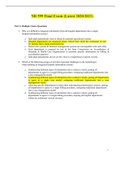Samenvatting
Summary course 3.5 Organizational Psychology
- Instelling
- Erasmus Universiteit Rotterdam (EUR)
Summary of all the literature used in course 3.5 of the organizational psychology specialization (International Bachelor of Psychology). Includes lecture notes. Individual Authors Mentioned + Article Name
[Meer zien]













